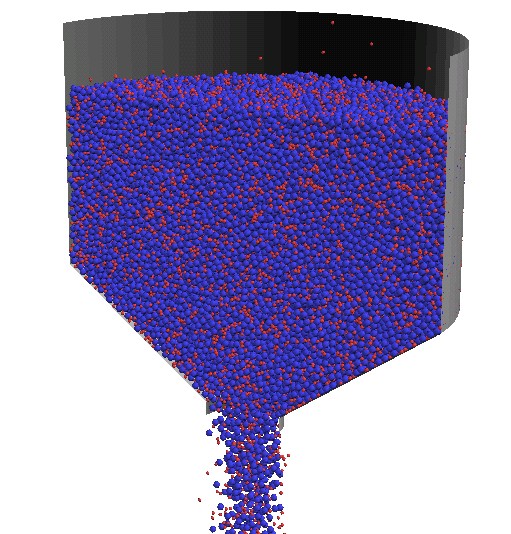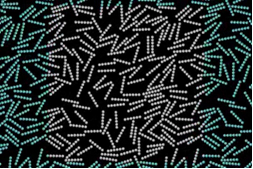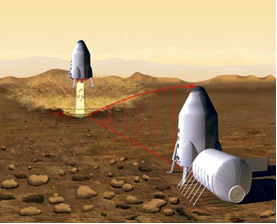Particulate flows are prevalent across a diverse range of industrial and geophysical processes. Examples include pharmaceutical processes, conveying lines for transporting minerals, ores, food and agricultural products, fluidized bed reactors, debris flows, and sediment transport. Several ongoing projects are outlined below:
Particle Segregation in Hopper Flows
 Granular materials typically consist of particles with a distribution of sizes, shapes, and densities, which, upon handling, may induce segregation of the material. This segregation of granular materials is undesirable for many solids handling processes as the product quality is often contingent on maintaining blend homogeneity – such as tablet production in the pharmaceutical industry. Our research uses the discrete element method (DEM) to investigate the effects of various hopper geometries and particle properties on the segregation of a spherical, bidisperse granular material during hopper discharge. Current studies also incorporate the effect of particle cohesivity due to liquid bridging. The computational results are compared to those from a small experimental system which is the ASTM standard test for sifting segregation.
Granular materials typically consist of particles with a distribution of sizes, shapes, and densities, which, upon handling, may induce segregation of the material. This segregation of granular materials is undesirable for many solids handling processes as the product quality is often contingent on maintaining blend homogeneity – such as tablet production in the pharmaceutical industry. Our research uses the discrete element method (DEM) to investigate the effects of various hopper geometries and particle properties on the segregation of a spherical, bidisperse granular material during hopper discharge. Current studies also incorporate the effect of particle cohesivity due to liquid bridging. The computational results are compared to those from a small experimental system which is the ASTM standard test for sifting segregation.
Non-Intrusive Measurements of Dilute and Dense-Phase Fluid-Solids Flows using Laser Doppler Velocimetry (LDV)
 Currently, fundamental predictive models for fluid-particle flows are for processes operating exclusively in either the inertia-dominated regime – where the influence of the fluid phase on direct interactions between particles is neglected, or the macroviscous regime – where the fluid phase plays the significant role in the mechanics of particle momentum transport. Both of these regimes of flow occur in gas-solid and liquid-solid systems. One key limitation impeding the development of fundamental models in the ‘transitional’ regime – between the inertia-dominated and the macroviscous regimes – is the lack of detailed, non-intrusive flow measurements. Hence, this research involves LDV experimentation in a unique, pilot-scale, slurry flow loop. By varying the flow velocity, particle concentration, and particle size, we span the range of particulate flow regimes. In addition, through the use of index of refraction matching, both dilute and dense-phase particle flows can be explored.
Currently, fundamental predictive models for fluid-particle flows are for processes operating exclusively in either the inertia-dominated regime – where the influence of the fluid phase on direct interactions between particles is neglected, or the macroviscous regime – where the fluid phase plays the significant role in the mechanics of particle momentum transport. Both of these regimes of flow occur in gas-solid and liquid-solid systems. One key limitation impeding the development of fundamental models in the ‘transitional’ regime – between the inertia-dominated and the macroviscous regimes – is the lack of detailed, non-intrusive flow measurements. Hence, this research involves LDV experimentation in a unique, pilot-scale, slurry flow loop. By varying the flow velocity, particle concentration, and particle size, we span the range of particulate flow regimes. In addition, through the use of index of refraction matching, both dilute and dense-phase particle flows can be explored.
Development of a Constitutive Model for Stress/Viscosity of Non-Spherical Particles
 Virtually all solid handling operations involve non-spherical particles, and the influence of particle shape on particle flow behavior is significant. However, most fundamental studies of particulate material undertaken to date involve spherical particles. Hence, the present work aims at developing constitutive relations for the particle-phase stress, needed in continuum-based models, incorporating the effect of particle shape. In order to develop such relations, we investigate the flow of particles of different shapes – various polygons and elongated particles with various aspect ratios – via DEM in planar shear flow. The particle-phase stress associated with these various shaped particles is then “measured“ as a function of the solids volume fraction, coefficient of restitution, and solids friction.
Virtually all solid handling operations involve non-spherical particles, and the influence of particle shape on particle flow behavior is significant. However, most fundamental studies of particulate material undertaken to date involve spherical particles. Hence, the present work aims at developing constitutive relations for the particle-phase stress, needed in continuum-based models, incorporating the effect of particle shape. In order to develop such relations, we investigate the flow of particles of different shapes – various polygons and elongated particles with various aspect ratios – via DEM in planar shear flow. The particle-phase stress associated with these various shaped particles is then “measured“ as a function of the solids volume fraction, coefficient of restitution, and solids friction.
CFD Simulation of Rocket Exhaust Interaction with Lunar Soil
 Debris transport due to rocket plume impingement onto lunar soil can cause significant damage to spacecraft and other surrounding equipment during lunar landing operations. Hence, the liberation of dusty lunar soil is potentially the highest risk facing lunar exploration system architectures. In order to mitigate this problem, we are developing a continuum-based, two-phase flow simulation model, in collaboration with CFD Research Corporation, to predict the severity and range of dust and debris transport and to design debris impact mitigation strategies. Specifically, one current area of focus is the improvement of lunar soil models which is key to accurate prediction of cratering and particle liberation.
Debris transport due to rocket plume impingement onto lunar soil can cause significant damage to spacecraft and other surrounding equipment during lunar landing operations. Hence, the liberation of dusty lunar soil is potentially the highest risk facing lunar exploration system architectures. In order to mitigate this problem, we are developing a continuum-based, two-phase flow simulation model, in collaboration with CFD Research Corporation, to predict the severity and range of dust and debris transport and to design debris impact mitigation strategies. Specifically, one current area of focus is the improvement of lunar soil models which is key to accurate prediction of cratering and particle liberation.





